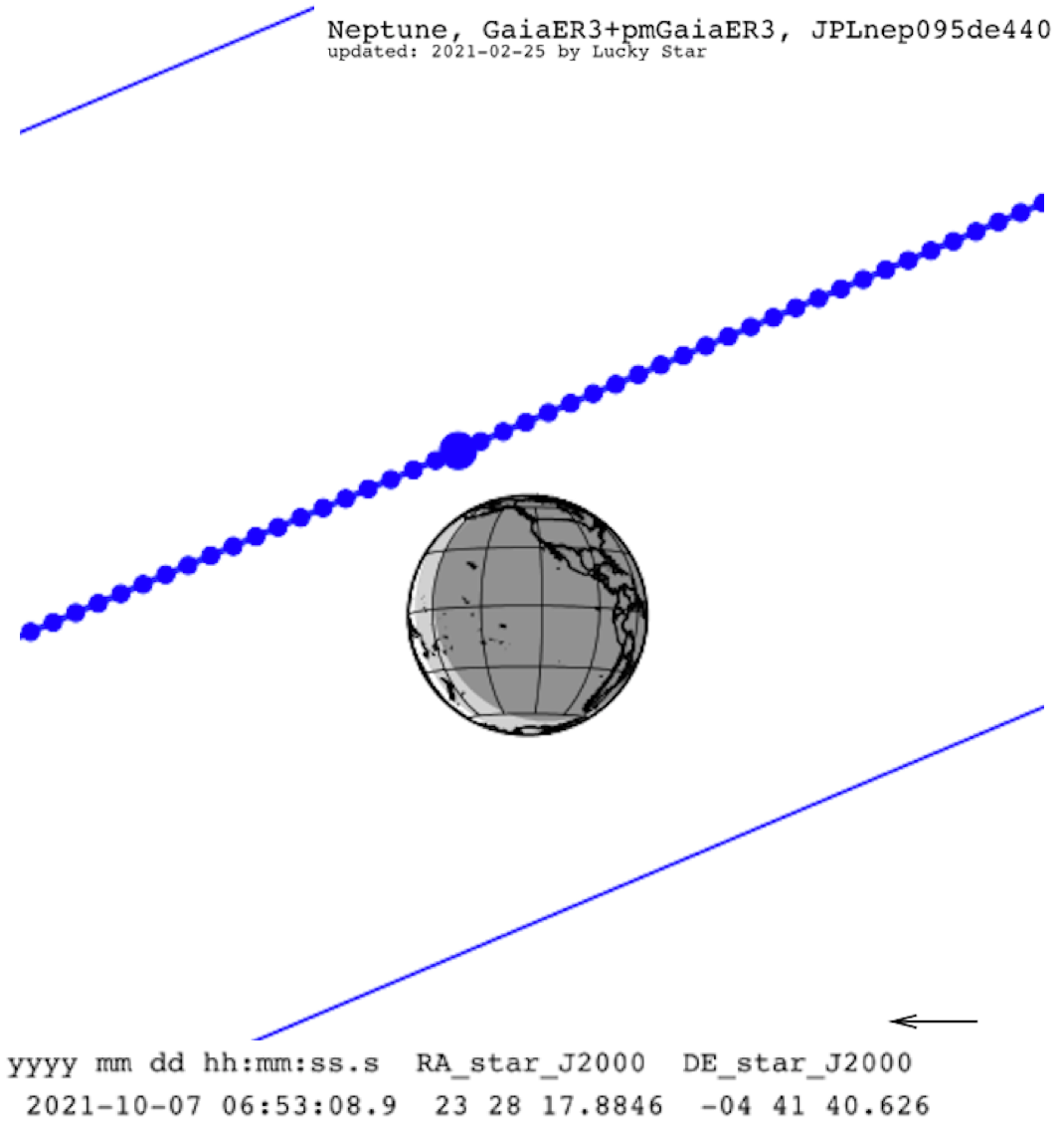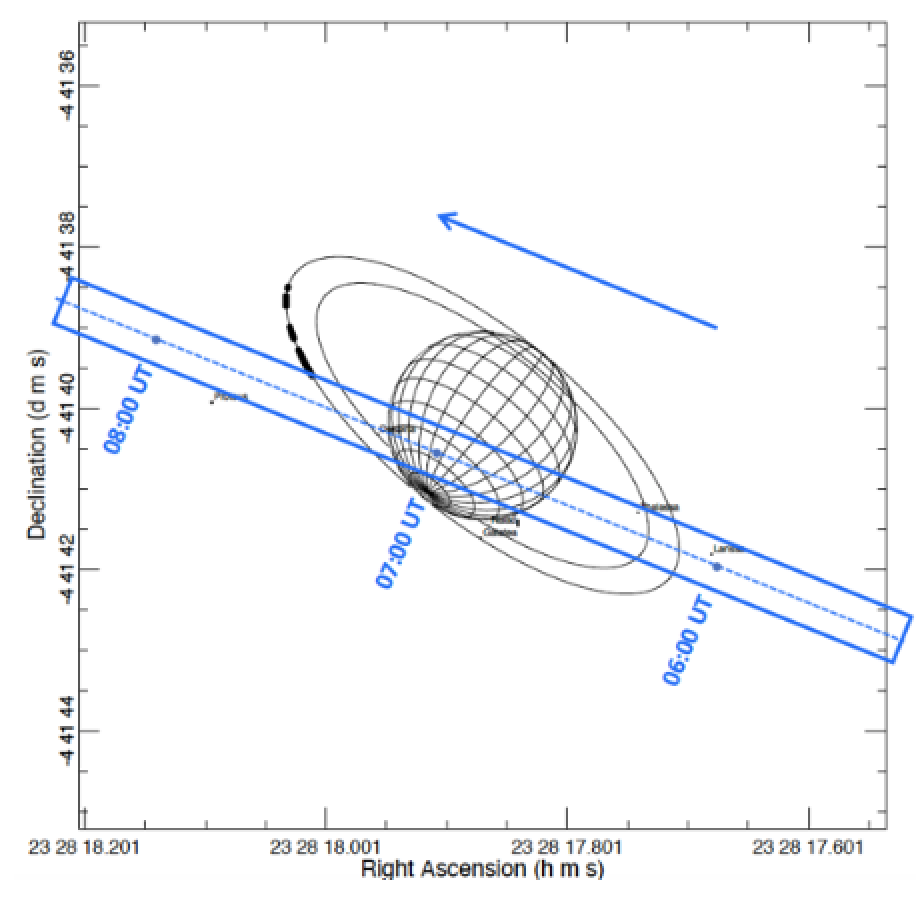IoW_20211222 - Gaia
Image of the Week
The 7 October 2021 stellar occultation by the Neptunian system
(the first large scale study since Voyager 2)
|
|
Figure 1: Left: Geometry of the Neptune occultation of 7 October 2021, shown at the geocentric closest approach at 06:53:08.9 UT. Dark and light grey areas are in the night and twilight, respectively. The dots along the thick central blue line show the motion of Neptune’s shadow centre every minute, whereas the other two thinner blue lines show the N and S shadow limits. Observations were organised from Hawaii, North, Central, and South Americas, using large and medium-sized telescopes. Right: Neptune Viewer (FoV 10”×10”) at the time of occultation over which the Earth’s motion projected onto Neptune is plotted. The blue arrow indicates the direction of motion. The occultation concerns the Adams (outermost) and Le Verrier rings as well as Neptune’s southern hemisphere (probing its atmosphere). Three time stamps for the event (6:00, 7:00, and 8:00 UT from right to left) are indicated on the plot as reference. This figure also shows that the occultation by the arcs (represented in thicker black lines along the outermost Adams ring) is not observable from Earth. Image credit: Lucky Star Project
On October 7, 2021, The Lucky Star team at Observatoire de Paris (France) led and organised the largest occultation and imaging campaign by the Neptunian system ever undertaken since the Voyager flyby in 1989. This occultation event was observable across the Americas (North, Central, and South) as well as in Hawaii, and the campaign involved all large telescopes in the region that were equipped with fast cameras either in the infra-red K band (2.2 μm) or in the visible using a CH4 filter at 890 nm.
Several historical occultations by Neptune have been observed throughout the 1980s up to 1990. However, as Neptune has since been receding from the Galactic plane, predicting such events became difficult. An occultation with only one station was, however, observed in 2008.
The prediction of the October 2021 event was made possible thanks to the Gaia EDR3 catalogue. The occulted star is Gaia EDR3 2633285513360476416, for which the highly accurate Gaia position and proper motion contributed to the prediction.
This work was led by the Lucky Star team: Damya Souami and Bruno Sicardy (LESIA/ Observatoire de Paris), Josselin Desmars (IPSA/IMCCE/ Observatoire de Paris), and Jean Lecacheux (Observatoire de Paris). A total of 15 large and medium-size telescopes were mobilised for the event: the largest telescopes in Hawaii (CFHT, IRTF, Keck, Gemini North), Arizona (Large Binocular Telescope - LBT, Vatican Advanced Technology Telescope - VATT), Las Cumbres Observatory - LCO (LCO McDonald in Texas and LCO at Cerro Tololo Observatory in Chile), Mexico (San Pedro Martir), Peru (Observatorio Astronómico de Moquegua), in Chili: Gemini South, VLT/UT3 & UT4 at ESO, NTT/ESO, and MPG 2.2m telescope. The work was conducted with 45 collaborators across Europe (France, Germany, Italy, and Spain), South Africa, Canada (Université de Montréal), USA (UC Berkeley, LBT, VATT), Peru, Mexico, Brazil, and ESO (Paranal and La Silla).
This October 2021 occultation campaign, coming more than thirty years after Voyager, allows to search for any variation in the distribution of the rings (e.g., searching for clumps, small co-orbital satellites, and confined material) and to probe the upper atmosphere of Neptune.
Figures 1 and 2 allow to grasp the spatial dimensions of the problem. While Earth’s diameter is ~12,100 km, Neptune’s diameter is over 4 times that value, namely ~49,500 km. The occultation event was observable across the Americas and from Hawaii. Given the aforementioned dimensions, this means that a global telescope coverage from North to South would only allow to probe about half of Neptune’s southern hemisphere.
Nine telescopes (in the northern and southern hemispheres) have already confirmed that high-quality data were successfully obtained. The data analysis has begun and looks very promising so far.
References and further reading:
- Hubbard, W. B., et al. 1986. "Occultation detection of a neptunian ring-like arc" Nature 319, 636 – 640
- Sicardy, B., et al. 1991. "Neptune's rings, 1983-1989: Ground-based stellar occultation observations I. Ring-like arc detections" Icarus 89, 220 – 243
- Smith, B. A. et al., 1989. "Voyager 2 at Neptune: Imaging Science Results" Science 246, 1422 – 1449
- Hubbard, W. B., et al. 1987. "Oblateness, radius, and mean stratospheric temperature of Neptune from the 1985 August 20 occultation" Icarus 72, 635 – 646
- Lellouch, E., et al. 1986. "Occultation determination of Neptune's oblateness and stratospheric methane mixing ratio" Nature 324, 227 – 231
- French, R. G., et al. 1998. "Neptune's Stratospheric Winds from Three Central Flash Occultations" Icarus 136, 27 – 49
- Roques, F., et al, 1994. "Neptune's upper stratosphere, 1983-1990: ground-based stellar occultation observations III. Temperature profiles" A&A 288, 985 – 1011
- Uckert K., et al., 2014. "An investigation of the température variations in Neptune's upper stratosphere including a July 2008 stellar occultation event" Icarus 232, 22
- de Pater, I. et al., 2005. "The dynamic neptunian ring arcs: evidence for a gradual disappearance of Libert_e and resonant jump of courage" Icarus 174, 263 – 272
- Renner, S., et al., 2014. "Neptune's ring arcs: VLT/NACO near-infrared observations and a model to explain their stability" A&A 563, 18
- de Pater, I., et al., 2018. "The Rings of Neptune" Planetary Ring Systems. Properties, Structure, and Evolution, 112 – 124
Credits: ESA/Gaia/DPAC; D. Souami, B.Sicardy, J. Desmars and J. Lecacheux from the Lucky Star Project (Observatoire de Paris, France), I. De Pater from UC Berkley California, USA; M. Langlois from Université de Lyon, France; S. Renner from IMCCE, Université de Lille, France; E. Lellouch from Observatoire de Paris; L. Albert from Université de Montréal, Canada; A. Sickafoose from the Planetary Science Institute (PSI) & Massachusetts Institute of Technology (MIT); R.A. Leiva Espinoza from U. de Chile; V. Ivanov from ESO München, Germany, A. Conrad and C. Veillet from Large Binocular Telescope Observatory, AZ, USA; R. Sfair from São Paulo State University, Brazil; from the Lucky Star Project in Brazil: G. Benedetti-Rossi (São Paulo State University, Brazil) and F. Braga-Ribas (Federal University of Technologym Curitiba, Brazil); L. Rousseau-Nepton, M. Baril, T. Vermeulen, N. Mansat, D. Devost, from the Canada France Hawaii Telescope, CFHT, Hawaii; J-B. Kikwaya Eluo, P. Garbor, R. P. Boyle, C. Hergenrother from the Vatican Advanced Technology Telescope, AZ, USA; T. Lister from Las Cumbres Observatory; A.W. Stephens, T.~Seccull, R. Salinas, Z. Hartman from the Gemini Observatory; J. Marques-Oliveira, T. Santana from the Lucky Star Project (Observatoire de Paris, France); J-L. Ortiz, R. Duffard, M. Kretlow, P. Santos-Sanz Santana from the Lucky Star Project (Instituto Astrofísica Andalucía, Granada, Spain); L. Mancini and R. Gredel from the Max Planck Institute for Astronomy, Heidelberg; A. Hempel Universidad Andrés Bello, Chile.
Published: 22/12/2021
- Removed a total of (5) style text-align:center;
- Removed a total of (8) style text-align:justify;
- Removed a total of (1) align=center.
- Removed a total of (1) border attribute.
- Removed a total of (1) cellpadding attribute.
- Removed a total of (1) cellspacing attribute.
Image of the Week Archive
- Removed a total of (1) border attribute.
- Removed a total of (1) cellpadding attribute.
- Removed a total of (1) cellspacing attribute.








































 Sign in
Sign in
 Science & Technology
Science & Technology

